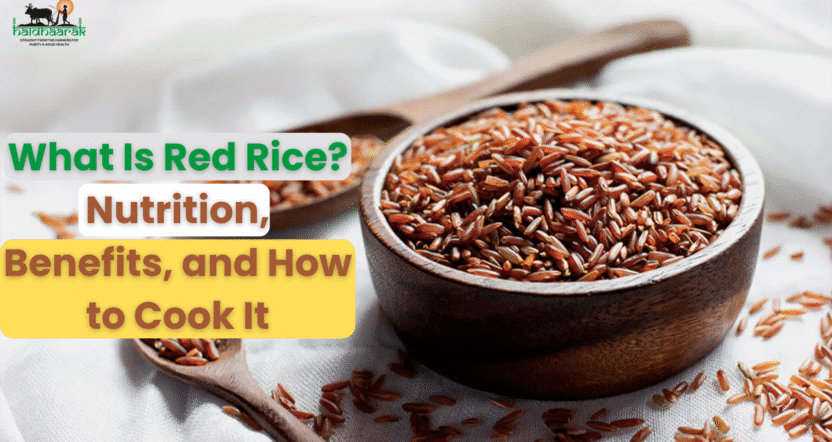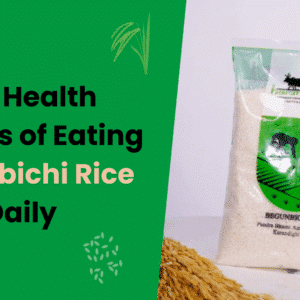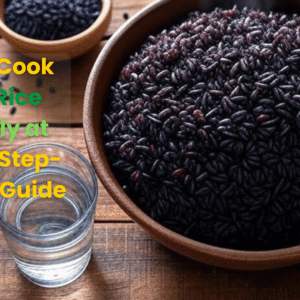Table of Contents
Red Rice is a special variety of rice that gets its reddish color from its outer layer, which is full of powerful antioxidants called anthocyanins. Unlike white rice, it is not heavily polished or processed. This makes it richer in nutrients and better for your health. Red rice has been eaten for centuries, especially in parts of India, Bhutan, and Southeast Asia. People choose it for its earthy flavor, chewy texture, and many health benefits.
In this article, you’ll learn about what red rice is, its nutrition facts, health benefits, and how to cook it easily at home. You’ll also discover some useful tips, fun recipes, and answers to common questions about red rice.
1. What Makes Red Rice Special? Understanding Its Origin and Varieties
Red Rice is not just one single type of rice. It includes many varieties like Bhutanese red rice, Thai red cargo rice, and Indian matta rice. These grains are grown in different regions, but all share a common feature – their reddish husk or bran layer.
This color comes from anthocyanins, which are natural plant compounds also found in blueberries and red cabbage. They help fight free radicals and keep the body healthy.
Key Varieties of Red Rice:
- Bhutanese Red Rice – Semi-milled and cooks quickly; has a soft texture.
- Red Cargo Rice – Popular in Thailand; long-grain and chewy.
- Matta Rice (Kerala Red Rice) – Bold and robust; common in South India.
- Kullakar Red Rice – Ancient rice variety from Tamil Nadu.
- Camargue Red Rice – A French version grown in the wetlands of Camargue.
Each type may taste slightly different, but all are rich in fiber, iron, and essential minerals.
Want to try the best-quality red rice? Buy Red Rice Online at Haldhaarak – handpicked, natural, and 100% farm-fresh!
2. Nutritional Value of Red Rice: Packed with Goodness
Red rice is a powerhouse of nutrients. Since it’s not heavily milled like white rice, it keeps most of its bran layer, which is full of health-boosting compounds.
Here’s a simple breakdown of what makes red rice healthy:
| Nutrient | Amount (per 100g) |
|---|---|
| Calories | 360 kcal |
| Protein | 7-8g |
| Carbohydrates | 75g |
| Dietary Fiber | 3-4g |
| Iron | 5-6mg |
| Magnesium | 120mg |
| Antioxidants | High (Anthocyanins) |
| Fat | <1g |
Health Highlights:
- Fiber helps in easy digestion and prevents constipation.
- Iron supports blood health and prevents anemia.
- Magnesium helps with bone strength and muscle function.
- Antioxidants reduce the risk of heart disease and cancer.
Harvard T.H. Chan School of Public Health – Whole Grains
So, if you’re looking for a grain that’s not just filling but also full of health benefits, red rice is your best bet!
3. Health Benefits of Red Rice: Why You Should Eat It
Red rice offers more than just color and taste—it brings amazing health benefits. Let’s explore how it helps:
- Supports Heart Health – The antioxidants in red rice reduce bad cholesterol (LDL) and keep your heart strong.
- Helps in Weight Loss – Rich in fiber, red rice keeps you full for a longer time and reduces overeating.
- Controls Blood Sugar – Since red rice has a low glycemic index, it helps in managing diabetes better than white rice.
- Improves Digestion – The natural fiber content supports smooth bowel movements and boosts gut health.
- Builds Strong Bones – Thanks to its magnesium content, red rice is great for bone strength and preventing cramps.
- Natural Detox – The antioxidants cleanse the body and keep your skin healthy and glowing.
For those managing weight, blood sugar, or looking for a daily super grain – Red Rice is the smart choice.
👉 Buy Red Rice from Haldhaarak – Natural, Chemical-Free & Wholesome
4. How to Cook Red Rice: Easy Steps for a Healthy Meal
Cooking red rice is simple, though it takes a bit longer than white rice. But it’s worth it!
- Ingredients Needed:
- 1 cup red rice
- 2.5 cups water
- Pinch of salt (optional)
- Steps to Cook Red Rice (Boiling Method):
- Wash and rinse the rice 2–3 times under running water.
- Soak the rice for 30–60 minutes (optional, helps soften it).
- In a pot, add 2.5 cups water to 1 cup of rice.
- Bring to a boil, then reduce to a simmer.
- Cook covered for 30–35 minutes until the grains are tender.
- Let it rest for 5 minutes before serving.
- Pressure Cooker Method:
- Use 1:2 water ratio.
- Cook for 3–4 whistles.
- How to Enjoy It:
- Serve with dal, curd, or vegetable curry.
- Use in salads, buddha bowls, or even fried rice!
5. Red Rice vs Other Rice: Which One Is Better?
Let’s compare Red Rice, White Rice, and Brown Rice to understand their differences:
| Type | Processing Level | Nutrients Left | Taste & Texture |
|---|---|---|---|
| Red Rice | Unpolished | High | Nutty, chewy |
| White Rice | Highly Polished | Low | Soft, neutral |
| Brown Rice | Semi-polished | Medium | Slightly nutty |
Why Red Rice Stands Out:
- More antioxidants than brown or white rice.
- Better for heart health and diabetes control.
- More filling, helps with weight loss.
- Naturally gluten-free and suitable for all age groups.
Red rice is not just another grain—it’s a supergrain. For families seeking a better rice alternative, this is the one.
Conclusion: Why Red Rice Deserves a Spot in Your Kitchen
If you care about health, flavor, and tradition, then Red Rice is perfect for you. It’s rich in nutrients, easy to cook, and goes well with any Indian meal. Whether you’re managing your weight, improving digestion, or just want a better grain, red rice checks all the boxes.
Don’t wait to upgrade your diet –
👉 Order Red Rice Online from Haldhaarak – Pure, Natural, and Delivered to Your Door.
Is red rice healthier than white rice?
Yes, red rice is healthier because it has more fiber, antioxidants, and nutrients than white rice.
Can diabetics eat red rice?
Yes. Red rice has a low glycemic index, making it suitable for people with diabetes.
How does red rice taste?
Red rice has a nutty, earthy flavor with a chewy texture, unlike the soft, bland taste of white rice.
Can I eat red rice every day?
Yes. You can eat red rice daily as part of a healthy diet, especially with vegetables or dal.
How do I store red rice properly?
Store red rice in an airtight container in a cool, dry place away from moisture.






